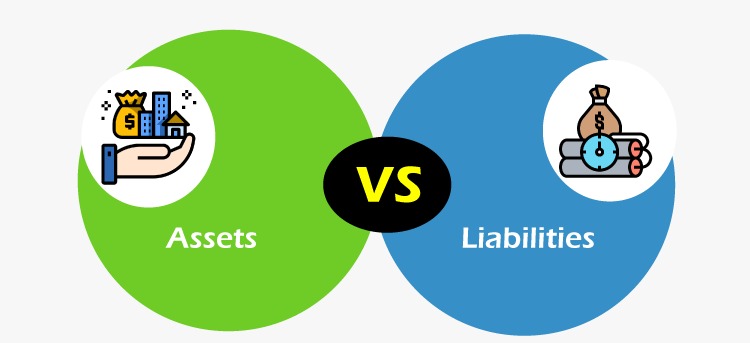Difference between Assets and LiabilitiesIn today's business and accounting technology, you might have heard the terms assets and liabilities. The assets can be understood as items of property. They have specific value and can be utilized to meet the obligation, commitment, debt, and legacies. On the other hand, the liabilities refer to the obligation of an individual and entity, which is recommended to be accomplished in the future. If the company invests money in assets, then the company gets benefits from assets like an increase in the company's profits. Both assets and liabilities play a very big role in businesses. The asset and liabilities decide the overall position of the Enterprise at the particular date with the help of the business sheet. Let us understand these terms in more detail. 
AssetsAssets are the things you OWN. Assets produce cash flow straight to your pockets. Examples of cash flow producing assets are divided into paying stock, bonds, business, rental property. Suppose you sold your old car and put the Rs. 15000 in a paper investment like stocks with an annual return of 7-12%. So, after one year, your investment will grow to Rs. 16,800. Key to utilizing Assets:The rich people do not work for their money. They use their money for work. The rich invest in assets rather than liabilities so they can passively produce more wealth. Imagine if you give attention to assets instead of liabilities. You will increase your wealth or cash faster. For example, if you choose to invest the Rs. 15000 which becomes Rs. 26,400 Rs. in your portfolio, you get a profit of Rs. 11,400. Classification of AssetsThe classification of assets is based on convertibility, physical existence, and usage. 1. Based on convertibility: We learn the two concepts that are Current and non-current. Current means short-term or less than one year. Non-current means a long term or more than a year. Current Assets: Current assets are short-term things you own. These are the assets that can easily be converted into cash. That means we can sell it and get immediate cash like marketable securities, debtors, bills receivable, bank balance, stocks and cash in hand. Non-current Assets: Non-current assets are long-term things you own. They are fixed assets. These assets are not converted easily into cash. Fixed assets say that it is assets which benefits are derived for a long time. Consider the example of a residential house according to your specifications, and you will sell it within a month and start with the new construction. No, you cannot sell the house; you still live in the house for a long period, which means the benefits you get for a longer period are fixed assets. Non-current Assets can be land and building, plant and machinery, furniture and fixtures, goodwill, patents, etc. The benefits of which are derived for a long period of time. They are called fixed assets. 2. Based on physical existence: Tangible assets: The assets which have a physical presence that we can see, touch, feel are called Tangible assets. The physical presence bodies are land and building, plant and machinery, furniture, cash, stock. Intangible assets: The assets which have no physical presence, which we cannot see, cannot touch, cannot feel are called intangible assets. The non-physical presence bodies are goodwill, patents, copyright, etc. 3. Based on usage: Operating assets: These assets are required in the daily operations of the business that means without those assets, we cannot continue with the daily operations. Such as building, land, plant and machinery, furniture, cash, goods this is used in business. Without plant and machinery, the daily operations cannot be continued. Non-operating assets: These assets are not required for daily business but can generate some revenue. Like when we have a fixed deposit, we receive the interest that means we are getting the income, so we say that can still generate some revenue. We cannot use fixed deposits for daily operations. In daily operation, we used a current account or saving account. Short-term investment, shares in the company. Fictitious Assets: Actually, it is not an asset. Fictitious Assets are losses or expenses that users or companies face. In that assets, profits are not getting within one year. For example, the company spends one lakh rupees on the advertisement. By advertising sales of the company are increased. But it required time to earn money which is spent on advertisement. In that condition, it earns that money in maybe 5 years, 6 years, or 10 years. It depends on sales how much time is required to earn that money. And if they face any loss, it is called deferred revenue expenditure. LiabilitiesLiability is the thing you owe. Liabilities produce expenses or take away from your pockets. Examples of liabilities that generate expenses are a car, home, a boat, cable TV. Real word example if you have 15000 rupees in saving and decide to buy a new car. You will be sending your money on liability. After one year, your car would have depreciated as much as 20%. Now, its worth is only 12,000 rupees and after five years' worth of that car is 5,500 rupees. It shows a loss of 9,500 rupees. Classification of liabilities:
Difference between Assets and Liabilities
Next TopicDifference between
|
 For Videos Join Our Youtube Channel: Join Now
For Videos Join Our Youtube Channel: Join Now
Feedback
- Send your Feedback to [email protected]
Help Others, Please Share










